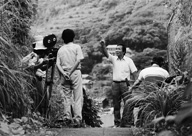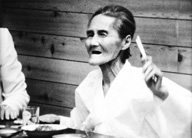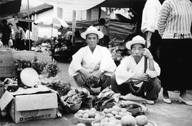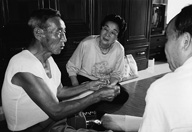Testament of the Times
1 Mori Zenkichi
Mori Zenkichi has many faces: playwright, writer for TV and radio, Noh critic, and film director. This film appeals to the people of the world on behalf of the Korean hibakusha (victims of the atomic bomb), who have endured countless tragedies, and in memory of the reprehensible death of the Koreans who were killed by the bomb.
To the People of the World: A Record of Korean A-bomb Victims
(“Sekai no hito e: Chosenjin hibakusha no kiroku”) JAPAN / 1981 / Japanese / Color / 16mm / 47 min
JAPAN / 1981 / Japanese / Color / 16mm / 47 min
Director, Producer: Mori Zenkichi
Photography: Kim Duk-chul, Kishi Hiroaki, Kimitsu Ko
Editing: Nagao Yoshiyuki, Takahashi Hiroko
Sound: Nakazato Katsunori, Aihara Masayuki, Miyazaki Masazumi
Music: Goto Hideo, Kojima Tomoyuki, AXIS, Mizutani Tadanobu, Ishijo Taro, Tomita Michiko
Location Sound: Koike Junichi
Sound Effect: Ogawa Masao
Narrator: Nakanishi Taeko
Assistant: Oh Choong-kong
Production Committee: Society for A Record of Korean A-bomb Victims
Source: Yuzawa Kazuki (“Yawarakaimizu”)
After his previous film To the Children of the World (1979), which depicted actual conditions faced by atomic bomb victims in Hiroshima, was honored with a prize at a film festival in Leipzig, Mori Zenkichi was asked by an organization of Korean atomic bomb victims in Hiroshima to make a film about them. Production started with money borrowed by mortgaging some of his own land.
2 Pak Su-nam
Pak Su-nam, known as the author of The Collected Letters of Ri Chin’u and Crime, Death and Love, was involved in the production of these two films. The films draw together historical testimony regarding the North and South Korean hibakusha in Hiroshima, and the issues of forced relocation and military comfort women in Okinawa.
The Other Hiroshima: Korean A-bomb Victims Tell Their Story
(“Mou hitotsu no Hiroshima: Ariran no uta”) JAPAN / 1987 / Japanese / Color / 16mm / 58 min
JAPAN / 1987 / Japanese / Color / 16mm / 58 min
Director, Narrative Structure, Planning: Pak Su-nam
Photography: Otsu Koshiro, Hoshino Kinichi
Editing: Tomizuka Ryoichi
Sound: Katto Isamu
Music: Hara Masami
Production Committee: Aoyama Kikaku (Yi Hae-son), Song of Arirang Production Committee
Source: Pak Su-nam
Living in a slum damaged by the atomic bomb and watching elderly first-generation zainichi hibakusha (atomic bomb survivors) pass away one after another, Pak felt compelled to break their silence with this documentary, her first. Using up all her savings and going into debt, she teamed up with cinematographer Otsu Koshiro and collected these testimonials from zainichi North and South Koreans living in Hiroshima and South Korean hibakusha visiting Japan for medical treatment. Although medical treatment for South Korean hibakusha began only in 1980, it was suspended in 1986, thus galvanizing support for this film.
Song of Arirang: Voices from Okinawa
(“Ariran no uta: Okinawa kara no shogen”) JAPAN / 1991 / Japanese / Color / 16mm / 100 min
JAPAN / 1991 / Japanese / Color / 16mm / 100 min
Director, Producer: Pak Su-nam
Photography: Otsu Koshiro, Miyauchi Ichitoku
Editing: Tomizuka Ryoichi
Sound: Katto Isamu
Music: Hara Masami
Production Committee: Song of Arirang Production Committee
Source: Pak Su-nam
Pak Su-nam followed The Other Hiroshima with this film focusing on accounts of Okinawa during World War II. In Okinawa, which was sacrificed to forestall an invasion of Japan’s main islands, Korean men were conscripted as “war laborers” and Korean women were enlisted as “comfort women.” Gathering testimony from zainichi Koreans, South Koreans and Japanese who were actually there, this film presents a more accurate view of history. The director has said that she made the film “as a requiem for those who died and to bring those souls back to life among us.” Accordingly, the final scene features an unforgettable requiem dance entitled “Arirang.”
3 Maeda Kenji
Maeda Kenji, who with films such as Resumes of the Gods (1988) and The Fluctuating Voices of Folklore (1991) has consistently traced Korean cultures in Japan, made this full-length documentary film about the history of the forced relocation and forced labor of Koreans from materials gathered from the Japanese areas of Okinawa, South Korea and China.
Telling the Stories of a Million Lives: Lamentation of Forced Korean Relocation and Labor
(“Hyakumannin no shinsetaryon: Chosenjin kyosei renko/kyosei rodo no han”) JAPAN / 2000 / Japanese / Color / 16mm / 225 min
JAPAN / 2000 / Japanese / Color / 16mm / 225 min
Director, Script, Producer: Maeda Kenji
Photography: Kitamura Tokuo
Music: Imai Shigeyuki
Narrator: Takayama Maki
Assistant Directors: Cho Hyun-soo, Lee Dae
Planning, Production Company, Source: Eizo Hanuru
This is a full-length documentary film focusing on “the forced relocation and labor of Koreans.” Maeda Kenji, who has persistently followed the culture of Koreans who were brought or came to Japan, spent four years completing this film. The work consists of five sections: The Association of the Pacific War Bereaved in Kwangju, Between Life and Death . . . , Former Military Comfort Women, The Emperor and Matsushiro and Atomic Bomb Hibakusha. Interviews were conducted by Maeda; Lee Ui-chik, who is second-generation zainichi and representative of the production company Eizo Hanuru; and Tezuka Yo, director of Human Conceit: The World of Director Kamei Fumio (1991).
